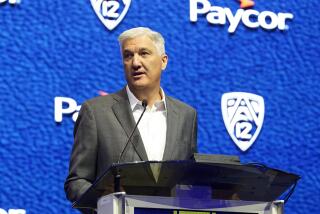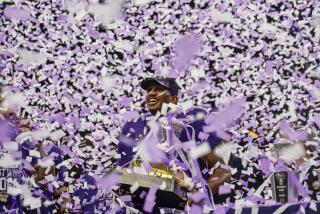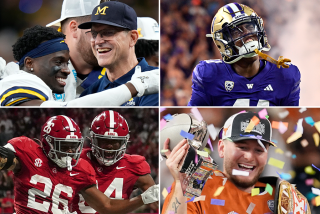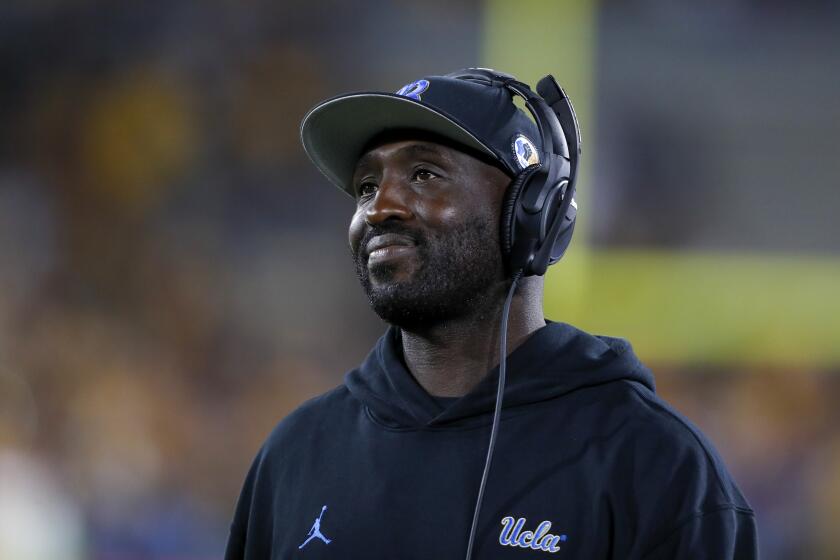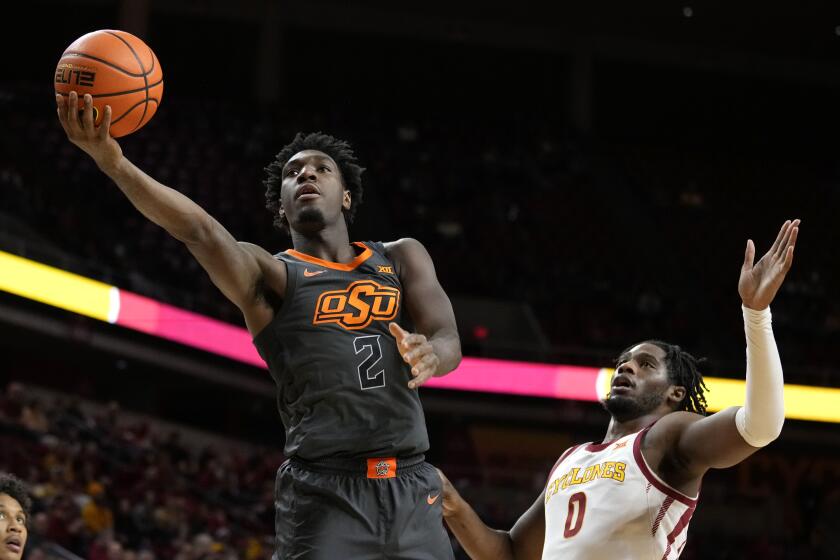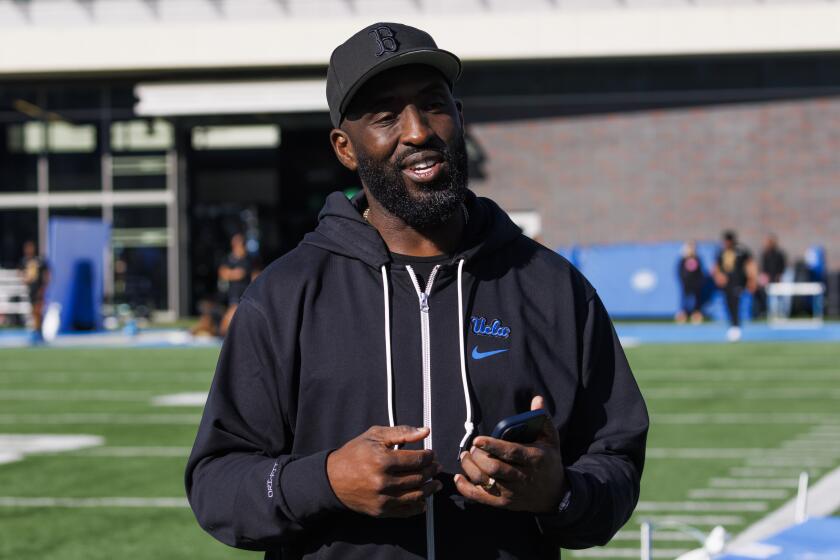Pac-12 football is catching up to the SEC

Pac-12 football has relentlessly tracked the Southeastern Conference for years — almost like Wile E. Coyote and the Road Runner.
The pursuit produced its share of botched ACME dynamite explosions, but could the SEC finally be cornered?
For the first time since 2005, the Pac-12 can look the SEC in the eye and say: “Yeah, we didn’t win the national title last year either.”
For the first time, maybe ever, the Pac-12 can say, “We have better coaches and better quarterbacks.”
This game of all-square may be temporary, but it’s also no mirage.
“The Pac-12 is probably better than it’s ever been and it’s not going backwards,” Arizona Coach Rich Rodriguez said this summer.
The new four-team College Football Playoff should also be a huge ego boost for the Pac after watching, for 16 years, the SEC deftly maneuver in the Bowl Championship Series.
Consider: The Pac had 20 teams finish in the top six of the final BCS standings, yet put only three teams into the 1-2 title game.
The SEC placed 26 in the top six, yet had 11 teams advance to the championship. The SEC won nine titles to USC’s lonely BCS crown (2004), which has since been vacated.
The new four-team system, applied retroactively in the BCS, would have given several Pac schools a shot at the title: Washington (2000), Oregon (2001), USC (2002), USC (2003), Stanford (2010), Stanford (2011), Oregon (2012).
The SEC set a high bar for dominance, but the Pac got serious in 2009 when Larry Scott became commissioner and started major renovations.
He first attempted to kidnap half the Big 12 and form the Pac-16.
Scott fell four schools short, settling for Pac-12, but sent notice he wasn’t settling for second. He then negotiated a $3-billion television deal and started marketing his conference like laundry detergent — stronger than dirt.
The influx of broadcast money has allowed schools to upgrade their facilities, improve pay for assistant coaches and procure some of the best coaches in America.
Washington State replaced Paul Wulff, for example, with Mike Leach. Arizona hired Rich Rodriguez and Arizona State got Todd Graham.
You know the league is strong when the least proven coach among the 12 is Oregon’s Mark Helfrich, who may have the best team … in the country.
The SEC has terrific coaches, too, led by Nick Saban (Alabama), Steve Spurrier (South Carolina), Mark Richt (Georgia) and Gus Malzahn (Auburn).
The Pac-12, arguably, seized the lead this year when it was able to send former USC coach Lane Kiffin back to the SEC (as an Alabama assistant), while Washington hired Chris Petersen away from Boise State.
The Pac-12 was considered last year, by most experts, the second best behind the SEC.
This year, it adds a clear and decided advantage at quarterback.
This is a cyclical quirk that resulted when the SEC’s top quarterbacks left at the same time the Pac12-’s best quarterbacks stayed.
Gone from the SEC are Texas A&M’s Johnny Manziel, Alabama’s AJ McCarron, Georgia’s Aaron Murray, Louisiana State’s Zach Mettenberger, South Carolina’s Connor Shaw and James Franklin of Missouri.
Back in the Pac-12 are 10 of last year’s starters.
The league figured to be tough enough even with the expected departures of Oregon’s Marcus Mariota and UCLA’s Brett Hundley.
The game changed when they put off the NFL and returned to tie up a few loose defensive ends.
“Never seen anything like this,” Stanford Coach David Shaw said of the quarterback gush. “I can’t wait for some of these guys to get out of the conference, which I thought a couple would last year and they disappointed me and came back.”
Let’s start the “C-list” of Pac-12 returners: Sefo Liufau (Colorado), Travis Wilson (Utah), Connor Halliday (Washington State), Jared Goff (California).
Colorado continues to labor but has reason for hope in Liufau, a sophomore who last year threw for 1,779 yards and 12 touchdowns in only seven starts. Utah’s Wilson is a fearless competitor who has been medically cleared after battling post-concussion syndrome.
Oh yeah, last year he completed 23 of 34 passes for 234 yards in the upset that kept Stanford out of the BCS title game.
Goff, as a freshman in Berkeley, passed for 3,508 yards on a bad Cal team.
Halliday is the senior trigger-man in Leach’s mad-scientist passing game. Halliday set a Washington State record with 4,597 yards last season. He tied Drew Brees’ NCAA single-game record with 89 pass attempts against Oregon.
Halliday also beat USC, in the Coliseum.
The Pac-12 “B-list”: Kevin Hogan (Stanford), Taylor Kelly (Arizona State), Cody Kessler (USC).
Hogan is a former Rose Bowl most valuable player who has led Stanford to consecutive Pac-12 titles, is 16-3 as a starter and 10-1 against top-25 opponents. Kelly, maybe be the league’s most underappreciated player, is a senior three-year starter who passed for 57 touchdowns the last two years. He also led his team in 2013 to the Pac-12 South title. Kessler is coming off an MVP performance in the Las Vegas Bowl and could put up big numbers in USC’s up-tempo offense.
The “A-list”: Mariota (Oregon), Hundley (UCLA), Sean Mannion (Oregon State).
Mariota is close to a perfect college player, a blend of speed, strength, grace and humility. A late knee injury last year likely cost him the Heisman Trophy, yet Mariota still topped 4,000 yards in total offense. Hundley is UCLA’s best quarterback since Cade McNown, while Mannion is set this year to eclipse Matt Barkley’s career Pac-12 passing yardage record.
“It’s a quarterback-driven game,” said Utah Coach Kyle Whittingham. “If you have a guy that pulls the trigger and can make plays for you at a high level, you can have a chance every week. This conference is loaded with them.”
The opinion here is the SEC still beats the Pac-12 in overall speed and size, particularly on defensive line and linebacker. No league runs sideline to sideline better than the SEC. No league has more freakish players like former South Carolina defensive end Jadeveon Clowney and Alabama linebacker C.J. Mosley.
The SEC is also better positioned for the playoff because it plays an eight-game schedule in a 14-team league. That allows for random misses such as playoff contender Mississippi in the West missing, this year, South Carolina, Georgia and Florida.
The Pac-12 plays a nine-game schedule and, historically, tougher opponents out of conference.
Pat Forde of Yahoo recently noted the Pac-12 this year will play 29.7% of its nonconference games against Power Five leagues or Notre Dame.
The SEC will play 19.6% of its nonconference against the Power Five.
The SEC can justifiably say it’s the best because it won nine of the 16 total BCS titles.
“They should claim themselves as the best league in the country because they’ve earned it and they’ve done it,” Arizona’s Rodriguez said of the SEC.
The Pac-12 hasn’t been standing still, though, and has a legitimate chance this year to claim No. 1.
“The commitment to football is at an all-time high in the Pac-12,” Rodriguez remarked. “I think the results of that are being shown on the field.”
Ultimately, though, results must also be displayed in trophy cases.
More to Read
Go beyond the scoreboard
Get the latest on L.A.'s teams in the daily Sports Report newsletter.
You may occasionally receive promotional content from the Los Angeles Times.
